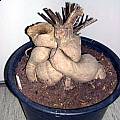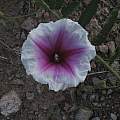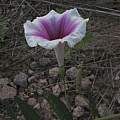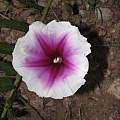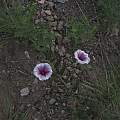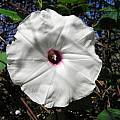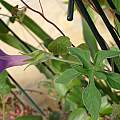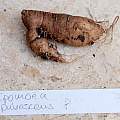Ipomoea L. is a genus in the Convolvulaceae family with species that are perennials and annuals that are found in North and South America, West Indies, Hawaii, Asia, and South Africa. The popular Sweet Potato, Ipomoea batatas, is a common garden plant in the United States, as is the Cardinal Climber, Ipomoea x multifida, which is a hybrid of I. quamoclit and I. coccinea.
Ipomoea fistulosa Mart. ex Choisy is considered by Plants of the World Online in 2025 to be a synonym of Ipomoea carnea ssp. fistulosa (Mart. ex Choisy) D.F.Austin. It is a summer-growing winter dormant twiner several meters long with a massive tuber. It flowers for months. Full sun, much water, do not overfertilize as it will grow lush on the expense of flowers. Not frost hardy but excellent in containers. Propagates easily from cuttings which should not be given a dormancy in their first winter as they may not yet have formed a tuber. Best grown outside in summer as it suffers from spider mite under glass, otherwise pest free, easy and rewarding. Height range: 6-9 ft. Information and pictures from Johannes-Ulrich Urban.
Ipomoea longifolia Benth. is native from southern Arizona through northern and central Mexico. The thick stems tend to trail along the ground rather than twine, and the flowers bloom at night. Height: to about 6 ft. Photos taken August 2008 in southeast Arizona by Eugene Zielinski.
Ipomoea pandurata (L.) G.Mey. is a species native to eastern North America. It is a perennial wild flower with large showy white flowers with purple centers. The flowers open in morning and wither in the heat of afternoon summer sun. Height range: 15-30 ft. The seeds are distinctive in having a ring of fur similar to a lion's mane. The second photo shows seeds that were lethally damaged by an insect. Photos by Dennis Kramb.
Ipomoea pubescens Lam., the silky morning-glory, is a antitropically distributed species from the Americas, reaching from Texas and Arizona to south-western Mexico, and again down the Andes to northwest Argentina. Flowering is triggered by the availability of water, allowing them to be grown like Dahlias in temperate climates with a cool and dry winter storage. Caudex enthusiasts may grow them with part of the tuber exposed.
All green parts, including the attractively lobed leaves are covered with fine white hair. The flowers are 4-5 cm (2") wide and deeply bluish purple. As usual with bluish Ipomoeas, the blue pigment is not UV stable and fades to purple by the time the flowers close, usually by late morning. The photos show a plant cultivated by Martin Bohnet.


